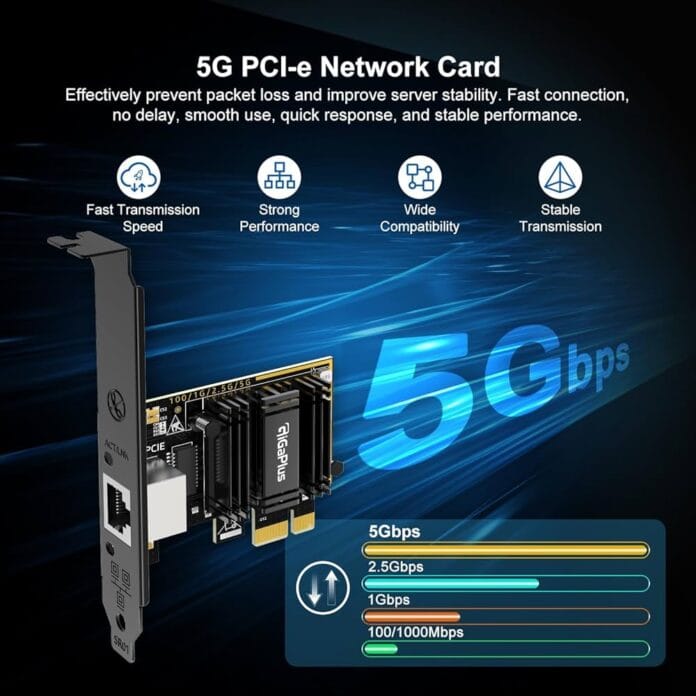In an era where blazing-fast internet has become the heartbeat of work, gaming, and entertainment, the humble Ethernet card often goes unnoticed — yet it’s one of the most powerful tools for achieving a stable, lightning-speed connection.
Unlike Wi-Fi, which can fluctuate with every wall and wave, an Ethernet card gives your PC or laptop a direct, reliable link to the network, ensuring low latency, higher speeds, and uninterrupted connectivity.
Whether you’re a gamer chasing every millisecond, a content creator uploading massive files, or a professional working remotely, the right Ethernet card can completely transform your online experience.
What Is an Ethernet Card?
An Ethernet card (also known as a Network Interface Card or NIC) is a hardware component that allows a computer, laptop, or server to connect to a wired network using an Ethernet cable. It acts as the bridge between your device and the local network (LAN), enabling fast, stable, and secure internet or intranet connectivity.
While most modern motherboards have built-in Ethernet ports, dedicated Ethernet cards offer better speed, reliability, and additional features for power users, gamers, and businesses.
⚡ How Ethernet Cards Work
- The card connects to the motherboard through PCIe or USB.
- An Ethernet cable is plugged into the RJ45 port on the card.
- The card translates data between the computer and the network.
- It communicates using TCP/IP protocols to transfer data packets efficiently.
💡 Result: Stable and low-latency wired internet connection — ideal for gaming, streaming, and professional use.
🚀 Types of Ethernet Cards
| Type | Speed | Interface | Typical Use |
|---|---|---|---|
| Fast Ethernet | 100 Mbps | PCI, USB | Basic browsing and office work |
| Gigabit Ethernet | 1 Gbps | PCIe, USB | Gaming, streaming, general use |
| 2.5G / 5G Ethernet | 2.5–5 Gbps | PCIe | Power users, content creators |
| 10G Ethernet | 10 Gbps | PCIe | Servers, workstations, data centers |
✅ Gigabit and 2.5G Ethernet cards are most common for modern home and office setups.
🧰 Ethernet Card Interfaces
- PCIe Ethernet Cards: Plug directly into a motherboard slot, offering higher speeds and lower latency.
- USB Ethernet Adapters: Portable, plug-and-play solutions for laptops or ultrabooks without Ethernet ports.
- Integrated NICs: Built-in on many motherboards but can be upgraded with a dedicated card for better performance.
🕹 Real-World Benefits of Using a Dedicated Ethernet Card
1. Faster Internet Speeds
A high-speed Ethernet card unlocks your full internet bandwidth (up to 10 Gbps or more), ideal for fiber connections.
2. Lower Latency
Wired connections are more stable than Wi-Fi. Gamers, streamers, and professionals experience fewer drops and faster response times.
3. Better Network Stability
Unlike Wi-Fi, Ethernet is not affected by interference or signal loss — crucial for uninterrupted video calls, online classes, or cloud work.
4. Improved Security
Wired connections are less vulnerable to external interference and offer more control over network security compared to wireless.
5. Server and Business Use
High-speed Ethernet cards are essential for file servers, NAS systems, and enterprise networks that transfer massive data volumes daily.
🆚 Ethernet vs Wi-Fi: Why Ethernet Cards Still Matter
| Feature | Ethernet Card | Wi-Fi Connection |
|---|---|---|
| Speed | Up to 10 Gbps+ | Typically 300 Mbps – 2 Gbps |
| Stability | Very high | Can fluctuate |
| Latency | Very low | Higher (especially on congested networks) |
| Security | More secure | More vulnerable |
| Ideal Use | Gaming, streaming, workstations | Mobile use, convenience |
💡 Wi-Fi is convenient — but Ethernet is faster, more stable, and more secure.
🔧 How to Install an Ethernet Card (PCIe)
- Turn off your PC and unplug it.
- Open the side panel of the CPU cabinet.
- Insert the Ethernet card into an available PCIe slot.
- Secure it with a screw and close the panel.
- Plug in the Ethernet cable and boot up your PC.
- Install drivers if required (most modern OS will detect automatically).
✅ You’re ready to enjoy a fast and stable wired internet connection.
🛍️ Popular Ethernet Card Brands
- TP-Link — Affordable, reliable consumer cards.
- Intel — Known for high-quality NICs with excellent driver support.
- ASUS — Gaming-focused Ethernet cards with low latency.
- Realtek — Commonly integrated NICs and budget adapters.
- Ubiquiti Networks — High-end networking gear for pros and enterprises.
🧭 Future of Ethernet Cards
- 2.5G and 10G Ethernet are becoming more affordable and are slowly replacing Gigabit Ethernet in high-speed homes and offices.
- Energy-efficient networking is improving power usage in modern NICs.
- Smart NICs with built-in processors are emerging in enterprise networks to offload tasks from the CPU.
🏁 Final Thoughts
Even in a wireless world, Ethernet cards remain a must-have for power users, gamers, content creators, and businesses that rely on speed, stability, and security.
If you have a fiber internet connection, a modern Ethernet card can unlock its full potential — giving you the smoothest possible online experience.
❓ Frequently Asked Questions (FAQ)
Q1. What is an Ethernet card used for?
A: It connects your computer or device to a wired network for fast, stable internet access.
Q2. Is Ethernet faster than Wi-Fi?
A: Yes. Ethernet offers lower latency and higher speeds compared to Wi-Fi.
Q3. Do I need to buy an Ethernet card if my PC has one built-in?
A: Not always. But a dedicated card can offer better speed and performance, especially if your current one is older.
Q4. What speed Ethernet card should I buy?
A: For most users, a 1 Gbps or 2.5 Gbps card is ideal. For professionals or servers, 10 Gbps is recommended.
Q5. Is it easy to install an Ethernet card?
A: Yes. Most PCIe Ethernet cards are plug-and-play and take just a few minutes to install.

